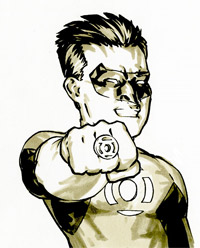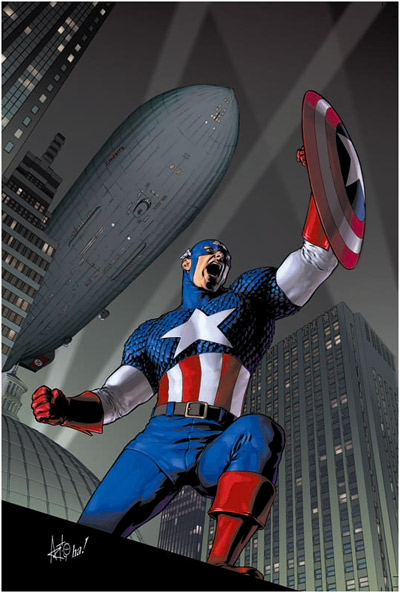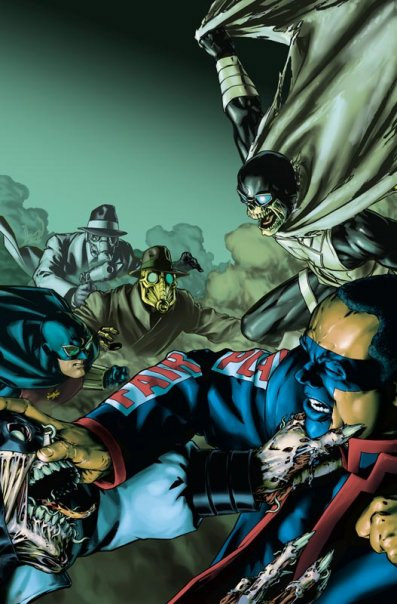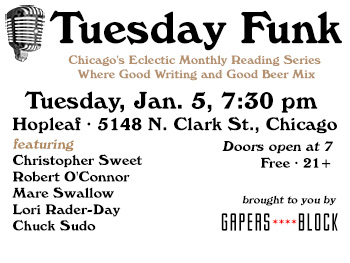| « What We're Reading: The Clothes on Their Backs | Bookmarks » |
Feature Thu Aug 05 2010
One-Shots: Gene Ha
Korean by birth, Midwest by association, Chicagoan by choice, Gene Ha is a master of lines and detail, expressed through regular work for both DC and Marvel, and various side projects. Best- known for his work on the Eisner-winning Top 10 and Top 10: The Forty-Niners, his path into comics been a long, beautifully illustrated, and meticulous road.
Name: Gene Ha
Job: Freelance comic book artist. Pencils, inks, and colors.
Age: Turning 41 in mid-August.
Education: BFA, specialty Illustration, from the College for Creative Studies, Detroit, 1992.
Awards: Russ Manning Most Promising Newcomer Award, 3 Eisners
Location: Berwyn, IL
Hometown: Born in Chicago, but raised in South Bend, IN
Website: http://geneha.com/, but I'm more active on Facebook.
Favorite place in Chicago: Uncommon Ground vs The Music Box. Depends on how hungry I am.


Self-portrait
How old were you when you started drawing?
My older brother and my younger both drew, so we've been drawing ever since we were little kids, so as long as I can remember. Every time I got a ditto sheet that wasn't double-sided in school, I'd draw on the back of it.
Were your parents artistic?
My dad's actually decent at drawing, but he never actually pushed it or studied it, so not really. My mom's really crafty, she'll pick up a craft and then get bored with it when she masters it.
Are you like that with drawing? Is it possible to master it?
The reason I became the guy who does the detailed drawings in my family was because I wasn't as good at sports as my other brothers, and I was the only one who lacked enough of a life, so I'd just sit at the same drawing for eight hours.

Page from The 49ers
What inspired you to make your drawings so detailed?
I grew up before there were computer graphics and stuff like that, and when I was a little kid, even before there were VHS tapes. I wanted to see these worlds, these Star Wars-like worlds and things more complex than that, but you couldn't see them on TV. A lot of them you couldn't even create inside of movies, with the technology then, so the only way to see them was to draw them.
Did you always want to go to school for art?
Oh yeah. I loved art as a kid, but my mom tended to tell me these horror stories about how artists go insane, cut off their ears. Somehow I learned the word lawyer, and they liked the sound of the word lawyer, so I started saying I wanted to be a lawyer even though I didn't know what it meant. Then after that, I found out "architect" was okay -- I really do love buildings, but I don't necessarily want to design them.

Captain America #18 cover
It's funny that you brought up being an architect: one thing that's always caught my eye with your work is the beautiful architecture and backgrounds. Did you always like drawing buildings?
A weird thing about me is that i liked the idea of cross-hatching as a kid, shading that way. But a lot of the cross-hatching I saw kind of sucked. And the best I could find was either old etchings, or on ten-dollar and twenty-dollar bills. So whenever I got a bill, I would run off to a photocopier somewhere, and I would blow it up as big as I could, and I would study how their technique. And if you look at my early work, there's more and more cross-hatching as I got better inkers -- very, very finely graded cross-hatching. But then my hand began cramping up, and I began getting headaches, it was taking too long. So I quit, because I wanted to keep my hand and my sanity.

Early cross-hatching
You said you kind of dropped out of comics for awhile after high school. How did you get back into it as a career?
In late college, a year before I graduated, I found a rack of comics inside a used clothing store. And the guy running it told me about the current comics industry -- saying you don't have to starve to do it, there's exciting stuff coming out. So I thought hey, maybe I'll try this.
Part of it was me thinking some of this stuff is really good -- but a lot's not as good as the stuff I remember from when back when I was in late high school, like the Matt Wagner, Frank Miller you know, all that type of stuff. Kent Williams. But then I thought that meant I could compete against these guys. There was so much badly done cross-hatching, a lot of it was ripoffs of Arthur Adams style, Barry Windsor-Smith style.
I thought, I could do cross-hatching better than them. My early stuff was a little weak- okay, it was really weak. But I kind of tied it up over the next few years, before I finally decided 'this is a fool's quest': trying to do this much cross-hatching, the shading in the black and white in the line art. Sometimes the colorist doesn't know what you're doing, and it clashes. I'm either going to have color it myself, or find a colorist I trust -- so that was my quest for the next few years.

Blackest Night: JSA #1 cover
We were talking a little bit about this earlier- artists like Brian Lee O' Malley, whose art is so different from yours-- why do you think there's a place for it?
If you're gonna do realistic anatomy, I want it done really well. But if you're' not going to do realistic anatomy, it's going to be cartoony, then just do that well. So that doesn't bug me at all. The storytelling in Scott Pilgrim was very effective.
Speaking of drawing people, do you feel like you draw differently when you're doing more traditional superhero comics, as opposed to when you were doing Top Ten?
It's kind of similar. Most of the characters in Top Ten didn't look especially heroic, so that changed a lot of things. Most things were supposed to look sad, and a little bit sick, and broken down. The other thing is, I had characters of such different heights, and there's so many long conversational shots that had both their heads in it, I had to get really creative with camera angles.
What did you like drawing in Top Ten?
I hated the cityscapes -- I enjoy the ideas of buildings, it's that thing of you need to do it right, so you're not unsettled afterwards. I like doing faces. If I could do a comic book that was just all headshots, I'd be happy but not satisfied...but I'd feel like it was such a ripoff, that it's not good storytelling.
It seems like you value backgrounds, even though they make you crazy.
The background needed to be very elaborate to make the storytelling in Top Ten work.
Do you think your surroundings have influenced the places you've drawn at all? The architecture of where you live?
It wasn't until 2003 that I actually lived in Chicago, but I've always lived kind of near it, Detroit and South Bend. So I've always kind of dreamed about it and thought about it. All my cities are a little bit Chicago. Especially Neopolis- if you go to the Chicago River downtown, and you look at all the different levels of Upper Wacker and Lower Wacker right on top of each other, it's pretty much Neopolis.

Neopolis









